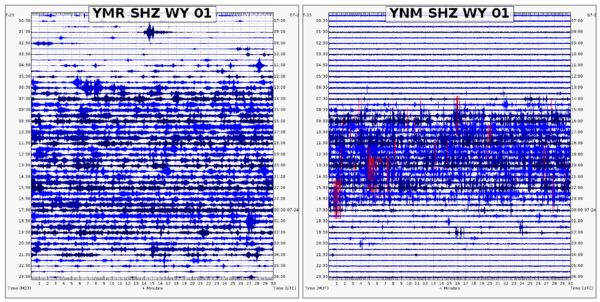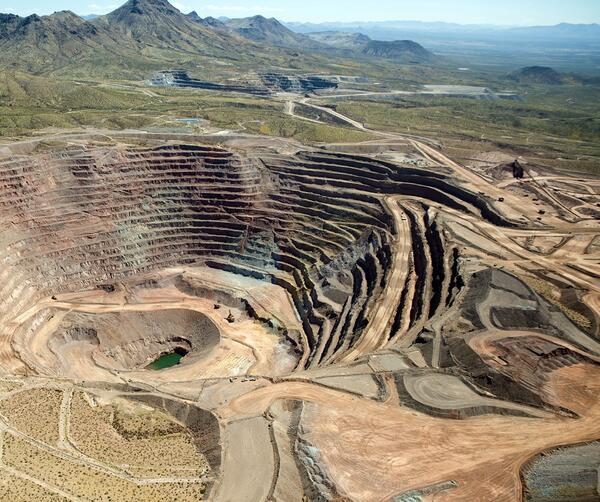Webicorders of Yellowstone Seismic Network stations YMR (West Entrance road) and YNM (Norris Geyser Basin Museum) showing traffic signals (left) and visitors walking (right) during daytime hours. Both records span the entire 24-hour period of July 23, 2024, MDT.
Does the Latest Earthquakes map show non-earthquake seismic events?
In addition to naturally occurring earthquakes, human activities such as mining and construction blasts can sometimes produce seismic waves large enough to be detected on the USGS national seismic network. These artificially-generated events have a different seismic ‘fingerprint’ from tectonic earthquakes, so they can be discerned by a seismologist when reviewed.
Specifically, small quarry blasts tend to have a shorter surface wave ‘echo’ than natural earthquakes. Seismologists also note if the blast was in an area NOT known for earthquakes and if it was located within 1-2 miles of an active quarrying operation. The USGS no longer does a systematic review of mining seismicity, but these events can sometimes be identified using certain criteria.
If we determine a seismic event to be a mining blast or some other non-earthquake event, we will designate it on our Latest Earthquakes map using a diamond icon. When searching the Earthquake Catalog, users can find non-earthquake events using ‘Advanced Options>Event Type’.
Additionally, IRIS (a USGS research partner) has an Exotic Seismic Events catalog.
Learn more:
- Routine United States Mining Seismicity
- Evidence Used in Identifying Routine Mining Seismicity
- Earthquake Booms, Seneca Guns, and Other Sounds
Related
How can you tell the difference between an explosion and an earthquake on a seismogram?
What are those booms I sometimes hear before or during an earthquake?
What does an earthquake feel like?
What are the earthquake hazards/risks where I live?
Where do earthquakes occur?
Where can I search an earthquake catalog for past events?
Did I feel an earthquake? Can I report feeling an earthquake?
Where can I see current or past seismograms?
How do seismologists locate an earthquake?

Webicorders of Yellowstone Seismic Network stations YMR (West Entrance road) and YNM (Norris Geyser Basin Museum) showing traffic signals (left) and visitors walking (right) during daytime hours. Both records span the entire 24-hour period of July 23, 2024, MDT.

Seismic and infrasound data for the April 15, 2024, hydrothermal explosion on Porcelain Terrace at Norris Geyser Basin
linkSeismic and infrasound data for the April 15, 2024, hydrothermal explosion on Porcelain Terrace at Norris Geyser Basin. Top plot is seismic data from the YNM station, located at the Norris Geyser Basin Museum. Middle plot is seismic data from station YNB, in the Ragged Hills of Norris Geyser Basin. Bottom plot is infrasound data from station YNB.&nb
Seismic and infrasound data for the April 15, 2024, hydrothermal explosion on Porcelain Terrace at Norris Geyser Basin
linkSeismic and infrasound data for the April 15, 2024, hydrothermal explosion on Porcelain Terrace at Norris Geyser Basin. Top plot is seismic data from the YNM station, located at the Norris Geyser Basin Museum. Middle plot is seismic data from station YNB, in the Ragged Hills of Norris Geyser Basin. Bottom plot is infrasound data from station YNB.&nb

Signals from a suspected icequake that occurred on Yellowstone Lake recorded at Yellowstone Seismic Network stations YLA on Lake Butte (top) and YTP at The Promontory (bottom 3 plots). Plot shows about 2 minutes of data from January 24, 2022, starting at about 7:43:34 p.m. MST. YLA waveform (YLA EHZ) was recorded on a vertical short-period sensor.
Signals from a suspected icequake that occurred on Yellowstone Lake recorded at Yellowstone Seismic Network stations YLA on Lake Butte (top) and YTP at The Promontory (bottom 3 plots). Plot shows about 2 minutes of data from January 24, 2022, starting at about 7:43:34 p.m. MST. YLA waveform (YLA EHZ) was recorded on a vertical short-period sensor.
Photograph of Freeport McMoRan-Safford Copper Mine in Arizona. Photograph taken by Thomas J. Porter (USGS) on September 19, 2016, Latitude 32.85992 deg N, Longitude -109.622
Photograph of Freeport McMoRan-Safford Copper Mine in Arizona. Photograph taken by Thomas J. Porter (USGS) on September 19, 2016, Latitude 32.85992 deg N, Longitude -109.622
Mine Blast at Silver Bell Mine, Arizona.
Mine Blast at Silver Bell Mine, Arizona.

Hydrothermal explosion at Biscuit Basin in Yellowstone National Park. These types of events are the most likely explosive hazard from the Yellowstone Volcano.
Hydrothermal explosion at Biscuit Basin in Yellowstone National Park. These types of events are the most likely explosive hazard from the Yellowstone Volcano.
Earthquake information products and tools from the Advanced National Seismic System (ANSS)
National earthquake information center strategic plan, 2019–23
Related
How can you tell the difference between an explosion and an earthquake on a seismogram?
What are those booms I sometimes hear before or during an earthquake?
What does an earthquake feel like?
What are the earthquake hazards/risks where I live?
Where do earthquakes occur?
Where can I search an earthquake catalog for past events?
Did I feel an earthquake? Can I report feeling an earthquake?
Where can I see current or past seismograms?
How do seismologists locate an earthquake?

Webicorders of Yellowstone Seismic Network stations YMR (West Entrance road) and YNM (Norris Geyser Basin Museum) showing traffic signals (left) and visitors walking (right) during daytime hours. Both records span the entire 24-hour period of July 23, 2024, MDT.
Webicorders of Yellowstone Seismic Network stations YMR (West Entrance road) and YNM (Norris Geyser Basin Museum) showing traffic signals (left) and visitors walking (right) during daytime hours. Both records span the entire 24-hour period of July 23, 2024, MDT.

Seismic and infrasound data for the April 15, 2024, hydrothermal explosion on Porcelain Terrace at Norris Geyser Basin
linkSeismic and infrasound data for the April 15, 2024, hydrothermal explosion on Porcelain Terrace at Norris Geyser Basin. Top plot is seismic data from the YNM station, located at the Norris Geyser Basin Museum. Middle plot is seismic data from station YNB, in the Ragged Hills of Norris Geyser Basin. Bottom plot is infrasound data from station YNB.&nb
Seismic and infrasound data for the April 15, 2024, hydrothermal explosion on Porcelain Terrace at Norris Geyser Basin
linkSeismic and infrasound data for the April 15, 2024, hydrothermal explosion on Porcelain Terrace at Norris Geyser Basin. Top plot is seismic data from the YNM station, located at the Norris Geyser Basin Museum. Middle plot is seismic data from station YNB, in the Ragged Hills of Norris Geyser Basin. Bottom plot is infrasound data from station YNB.&nb

Signals from a suspected icequake that occurred on Yellowstone Lake recorded at Yellowstone Seismic Network stations YLA on Lake Butte (top) and YTP at The Promontory (bottom 3 plots). Plot shows about 2 minutes of data from January 24, 2022, starting at about 7:43:34 p.m. MST. YLA waveform (YLA EHZ) was recorded on a vertical short-period sensor.
Signals from a suspected icequake that occurred on Yellowstone Lake recorded at Yellowstone Seismic Network stations YLA on Lake Butte (top) and YTP at The Promontory (bottom 3 plots). Plot shows about 2 minutes of data from January 24, 2022, starting at about 7:43:34 p.m. MST. YLA waveform (YLA EHZ) was recorded on a vertical short-period sensor.
Photograph of Freeport McMoRan-Safford Copper Mine in Arizona. Photograph taken by Thomas J. Porter (USGS) on September 19, 2016, Latitude 32.85992 deg N, Longitude -109.622
Photograph of Freeport McMoRan-Safford Copper Mine in Arizona. Photograph taken by Thomas J. Porter (USGS) on September 19, 2016, Latitude 32.85992 deg N, Longitude -109.622
Mine Blast at Silver Bell Mine, Arizona.
Mine Blast at Silver Bell Mine, Arizona.

Hydrothermal explosion at Biscuit Basin in Yellowstone National Park. These types of events are the most likely explosive hazard from the Yellowstone Volcano.
Hydrothermal explosion at Biscuit Basin in Yellowstone National Park. These types of events are the most likely explosive hazard from the Yellowstone Volcano.











